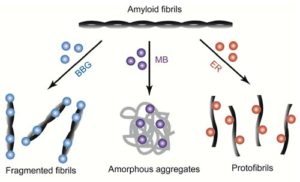 Irwin, Wong, Kwon. Biomacromolecules. 14(1): 264- 274.
Irwin, Wong, Kwon. Biomacromolecules. 14(1): 264- 274.
Amyloid fibrils such as those found in Alzheimer’s disease are thermodynamically very stable, but there is evidence that small molecules like food dyes can remodel them safely.
The authors performed a remodeling trial using methylene blue, brilliant blue G (Blue 1) and erythrosine B (Red 3).
- Methylene blue perturbed the fibrillary structure leading to amorphous aggregates
- Blue 1 fragmented the fibrils into shorter fibrils
- Red 3 separated the fibrils into protofibrils successfully.
All three are “promising candidates to remove insoluble amyloid fibrils deposited in the human brain.”




















